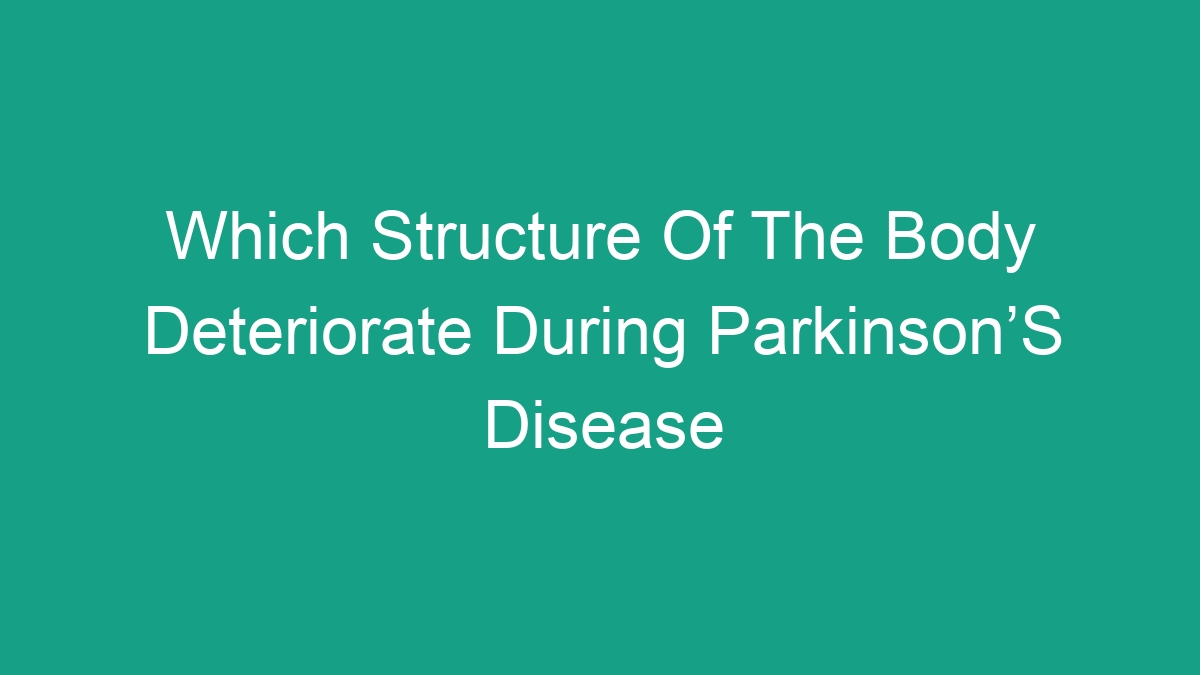
Introduction
Parkinson’s disease is a progressive neurological disorder that affects movement. It is characterized by a deterioration of certain structures in the body, leading to symptoms such as tremors, stiffness, and difficulty with balance and coordination. While the exact cause of Parkinson’s disease is still not fully understood, researchers have identified several structures in the body that deteriorate as the disease progresses.
In this article, we will explore which specific structures of the body deteriorate during Parkinson’s disease, the impact of this deterioration on symptoms, and potential avenues for treatment and management of the disease.
The Basal Ganglia
The basal ganglia is a group of structures located deep within the brain that play a critical role in controlling movement. It consists of several interconnected nuclei, including the substantia nigra, globus pallidus, and striatum. In Parkinson’s disease, the cells in the substantia nigra, specifically the dopamine-producing neurons, degenerate and die off.
This degeneration of the basal ganglia, particularly the loss of dopamine-producing neurons, is a central feature of Parkinson’s disease. Dopamine is a neurotransmitter that helps regulate movement and coordination, so the loss of dopamine in the basal ganglia leads to the characteristic motor symptoms of the disease, such as tremors, rigidity, and bradykinesia (slowness of movement).
The Nigrostriatal Pathway
The nigrostriatal pathway is a specific neural pathway that connects the substantia nigra to the striatum, another component of the basal ganglia. This pathway is responsible for transmitting dopamine signals that help regulate motor function.
In Parkinson’s disease, the degeneration of the nigrostriatal pathway disrupts the normal transmission of dopamine signals, leading to motor dysfunction. As dopamine levels decrease, the striatum becomes overactive, which results in the characteristic symptoms of Parkinson’s disease, such as involuntary movements and difficulty initiating and controlling voluntary movements.
The Brainstem and Nervous System
In addition to the basal ganglia, Parkinson’s disease also affects other structures in the brainstem and nervous system. The brainstem is a critical region that controls basic life functions such as breathing and heart rate, as well as the regulation of motor function.
During Parkinson’s disease, the degeneration of the brainstem and nervous system contributes to a wide range of non-motor symptoms, including autonomic dysfunction, sleep disturbances, and cognitive impairment. These non-motor symptoms can significantly impact a person’s quality of life and are often overlooked in the management of the disease.
The Lewy Bodies
Another hallmark of Parkinson’s disease is the presence of abnormal protein deposits in the brain known as Lewy bodies. These microscopic protein clumps are primarily composed of a protein called alpha-synuclein and are believed to play a role in the neurodegenerative process.
The formation of Lewy bodies is associated with the degeneration of nerve cells in the brain, particularly in regions involved in movement, cognition, and autonomic function. The presence of Lewy bodies is a key pathological feature of Parkinson’s disease and is often used to diagnose the disease post-mortem.
Impact on Symptoms
The deterioration of these structures in the body has a profound impact on the symptoms experienced by individuals with Parkinson’s disease. The loss of dopamine-producing neurons in the substantia nigra and the disruption of the nigrostriatal pathway lead to the hallmark motor symptoms of tremors, rigidity, and bradykinesia.
Additionally, the degeneration of the brainstem and nervous system contributes to a myriad of non-motor symptoms, including autonomic dysfunction, sleep disturbances, and cognitive impairment. These non-motor symptoms can be just as debilitating as the motor symptoms and often have a significant impact on a person’s overall well-being.
Treatment and Management
While there is currently no cure for Parkinson’s disease, several treatment options are available to help manage symptoms and improve quality of life for individuals with the disease. Medications that increase dopamine levels in the brain, such as levodopa and dopamine agonists, are commonly prescribed to alleviate motor symptoms.
Physical therapy and exercise can also help improve movement and reduce rigidity and stiffness. Additionally, certain non-pharmacological interventions, such as deep brain stimulation and gene therapy, are being investigated as potential treatment options for Parkinson’s disease.
Management of non-motor symptoms often involves a multidisciplinary approach, including the involvement of neurologists, psychiatrists, and allied health professionals. Addressing sleep disturbances, cognitive impairment, and autonomic dysfunction is essential for improving the overall well-being of individuals with Parkinson’s disease.
Conclusion
Parkinson’s disease is a complex neurodegenerative disorder that affects multiple structures in the body, leading to a wide range of motor and non-motor symptoms. The deterioration of the basal ganglia, nigrostriatal pathway, brainstem, and the formation of Lewy bodies all contribute to the progression of the disease.
While current treatments focus on managing symptoms, ongoing research into the underlying mechanisms of the disease offers hope for the development of more effective therapies in the future. Understanding the specific structures that deteriorate during Parkinson’s disease is crucial for identifying potential targets for intervention and improving the overall management of the disease.



